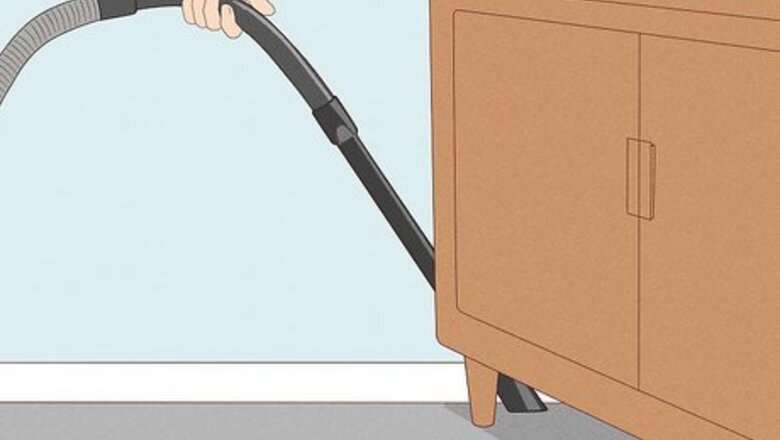
views
- Thoroughly vacuum your carpet, making sure to vacuum underneath furniture, near the baseboards, and around any doors or windows where fleas can enter.
- Treat your carpet with an insecticide that contains both an adulticide to kill adult ticks and insect growth regulators to kill eggs, larvae, and pupae.
- Sprinkle food-grade diatomaceous earth over your carpet for as a natural way to kill fleas.
Cleaning the Carpet
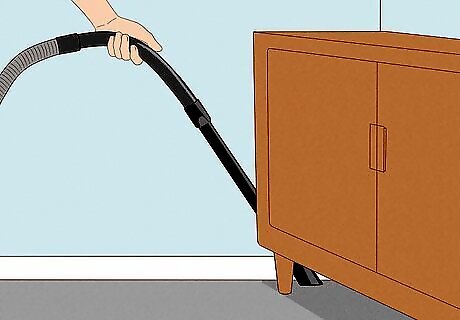
Vacuum your carpet thoroughly. Vacuuming is the most effective way to get rid of fleas and their eggs. Use the nozzle attachment instead of just pushing the vacuum cleaner to really get down deep into the carpeting and tight corners. Start at one end of the room, and vacuum in strips until you’ve covered the entire area. Fleas like to hide in dark and humid areas, so be sure to also vacuum underneath furniture well. If you have pets, pay special attention to areas that they like to spend time in, as well as around baseboards and near doors leading outside. For very heavy infestations, continue vacuuming every day for 10 to 14 days to kill fleas that continue to hatch from their eggs.
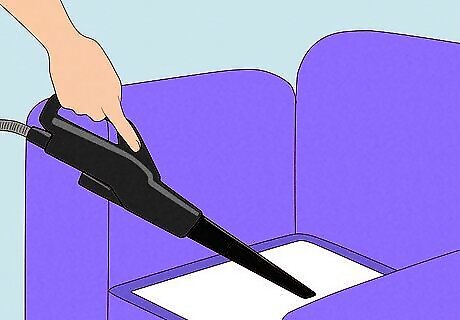
Vacuum any upholstered furniture in the room. Fleas often like to hang out on furniture like couches and armchairs, as well as in your bedding. Use the hose attachment on your vacuum to thoroughly suck up any fleas or eggs you see. Make sure to get the base and the underside of each piece of furniture as well. If you have a pet, be sure to vacuum their bedding, crate, and other things like carpeted scratching posts as well.

Throw away the vacuum cleaner bag outside. Take the bag out of the vacuum cleaner, put it in a plastic bag, and throw it away outside your house. This will prevent any remaining fleas from getting back inside your home and back onto your carpet. If your vacuum cleaner uses a canister instead of a bag, take the canister outside and empty the debris into a plastic bag. Throw the plastic bag out in a dumpster outside of your home.
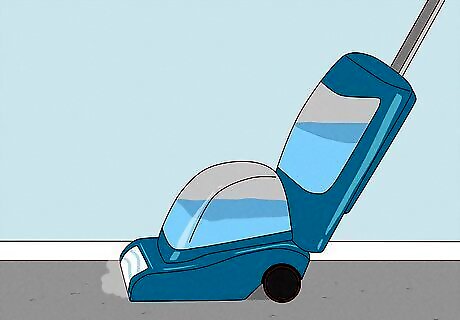
Steam clean your carpets and furniture. If you don’t own a steam cleaner, rent one from a home improvement or grocery store. Follow the instructions that come with the equipment carefully and thoroughly clean your entire carpet. Another option is to hire a steam cleaning company to clean for you. The high temperature exerted by the steam cleaner will kill both adults and eggs. EXPERT TIP Kevin Carrillo Kevin Carrillo MMPC, Pest Control Specialist Kevin Carrillo is a Pest Control Specialist and the Senior Project Manager for MMPC, a pest control service and certified Minority-owned Business Enterprise (MBE) based in the New York City area. MMPC is certified by the industry’s leading codes and practices, including the National Pest Management Association (NPMA), QualityPro, GreenPro, and The New York Pest Management Association (NYPMA). MMPC's work has been featured in CNN, NPR, and ABC News. Kevin Carrillo Kevin Carrillo MMPC, Pest Control Specialist Our Expert Agrees: Steam cleaning is one of the most effective, non-professional ways of removing fleas from your carpet. Make sure you test the steam cleaner on a hidden piece of the carpet first to see whether the steam will cause discoloration.
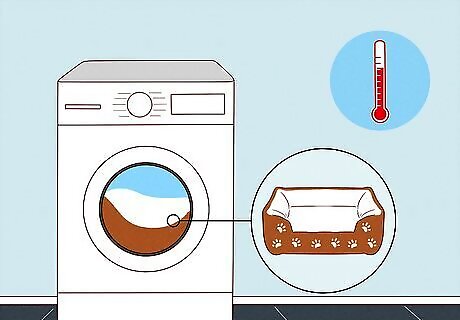
Wash linens and pet bedding with hot water. Wash your bedding, upholstery, and pet’s bedding with hot water and detergent in the washing machine to kill the fleas. Then, use the hottest dryer setting available. Wash these daily until the flea infestation is gone. Check the labels on each item to see if they can be washed in hot water.
Using Natural Treatments
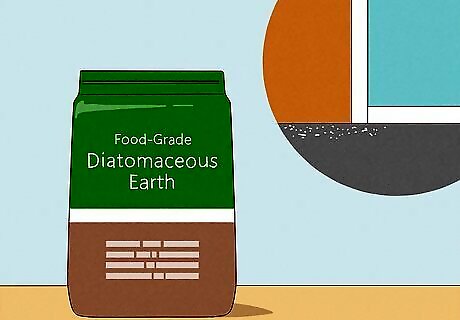
Sprinkle food-grade diatomaceous earth on the carpet to kill fleas. Diatomaceous earth is made from tiny, fossilized algae and will essentially cut the fleas up and kill them. Sprinkle it over your carpet and near entryways where fleas might be coming into your house. Let it sit for 2 to 3 days before vacuuming it up. Keep small children and pets off the carpet until you’re done vacuuming. Sprinkle some on your pet’s bed if you think fleas are hiding there. Just make sure your pet doesn’t use the bed until you’ve cleaned off the diatomaceous earth. Diatomaceous earth has a rough texture that can ruin standard, filtered vacuums and vacuums with bags. Instead, use a vacuum with a HEPA filter or a shop vac.
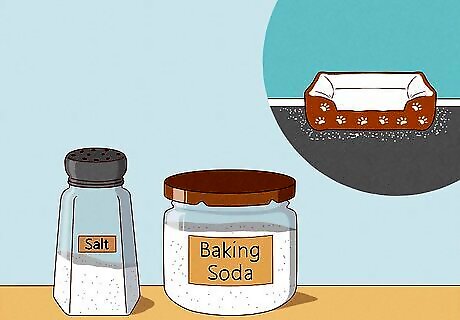
Sprinkle some salt or baking soda all over the carpet. Salt and baking soda are two natural remedies that will dry out fleas and potentially kill them. Sprinkle either of these two substances over your carpet, around places your pet likes to sleep, near doorways, around baseboards, and under furniture. Then, wait for 24 to 48 hours before vacuuming the salt or baking soda up. Salt that has a very fine grain will work best in this situation. Keep pets and small children away from the area until you’ve vacuumed up the salt or baking soda.
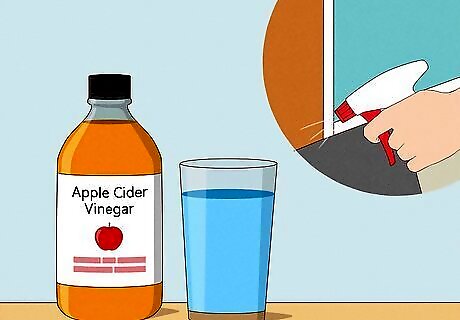
Spray a vinegar and water mixture over the area. Pour equal parts vinegar and water in a spray bottle and shake it thoroughly to mix them. Use either white vinegar or apple cider vinegar for this mixture. Then, go ahead and spray your carpet, paying extra attention to places your pet likes to be if you have one. Also be sure to spray around the baseboards, near entryways, and under furniture. Fleas dislike the smell of vinegar, and it may also aid in killing adult fleas.
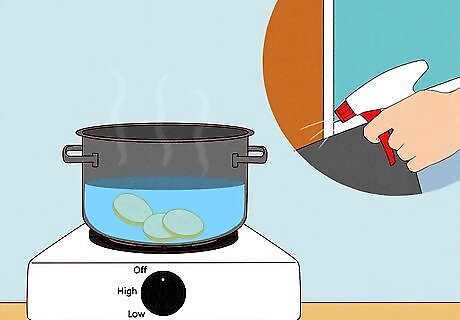
Spray lemon water as a natural repellent. Cut 1 to 3 lemons into thin slices and place them in a pot on the stove. Then, pour in 2 cups (473.2 ml) of water and bring the entire thing to a boil. Once the water begins to boil, take the pot off the burner and turn the stove off. Let the lemons sit in the water overnight. The next day, pour the lemon water into a spray bottle and spritz your carpet. Fleas dislike the smell of lemon. Also, lemon rinds contain essential oils that act as a natural flea repellent. This mixture will likely keep fleas away from your carpet rather than kill them. To make sure they’re really gone, be sure to also vacuum thoroughly once your carpet has dried.
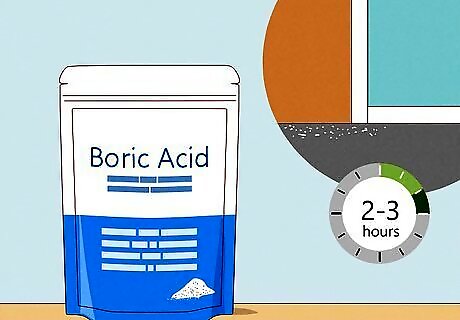
Use boric acid to poison fleas. This ingredient is likely available at your local home and gardening store. Sprinkle the boric acid thinly over your carpet and around the areas where you think fleas may be coming into your home. Let it sit on the carpet for 2 to 3 hours, then vacuum it up. Keep pets and children away from the area until you’ve vacuumed up the boric acid. When dealing with boric acid, protect yourself by wearing a disposable face mask and rubber gloves.
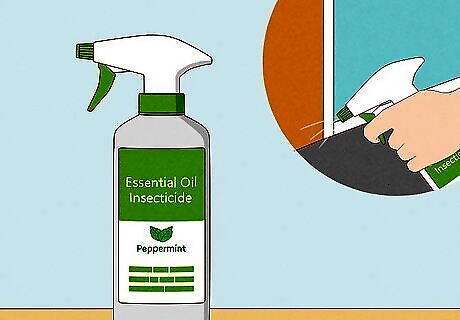
Kill fleas with essential oil insecticides. Certain essential oils are good at repelling or even killing fleas. Peppermint, lavender, and lemongrass are particularly effective against fleas. However, because essential oils can be harmful to pets, only use essential oils that are specially formatted as insecticides. These often come as a spray that you then spritz over the carpet. Spray the essential oil insecticide also near entryways to discourage fleas from coming into your house. While essential oil insecticides aren’t toxic to pets like pure essential oils, still keep pets and small children away from the area you’re spraying until it’s completely dry and absorbed.
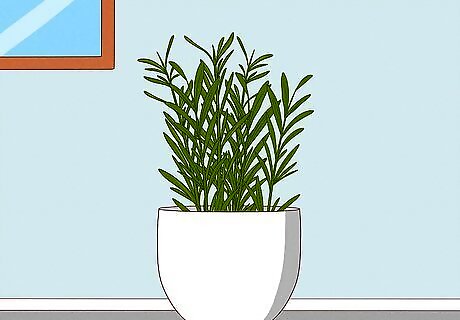
Keep fleas at bay with rosemary and other plants. Fleas will be repelled by certain plants because of their scents. These plants won’t kill fleas, but they will discourage them from entering your home. On top of that, they’re generally safe to have around pets. Purchase a flea-repelling plant and keep it inside your home. Plants that fleas hate include: Rosemary Lemongrass Lavender Chrysanthemums Catnip
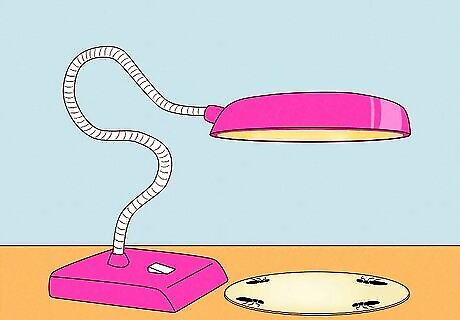
Make a light flea trap to catch adult fleas. If you don’t know where the fleas are in your carpet, corral them into a single area by using a flea trap. Place a sticky flea trap pad under a small electric light, like a desk lamp. The fleas will be attracted to the warmth and get stuck on the pad when they hop over. Something like sticker paper or even strips of masking tape (laid sticky side up) will also work for trapping fleas. Fleas will be more attracted to your trap if you turn off the light for 10 seconds every 5 to 10 minutes. Check your flea trap at least once a week. If you don’t catch any fleas, move it to a different spot and continue monitoring it.
Using Insecticides
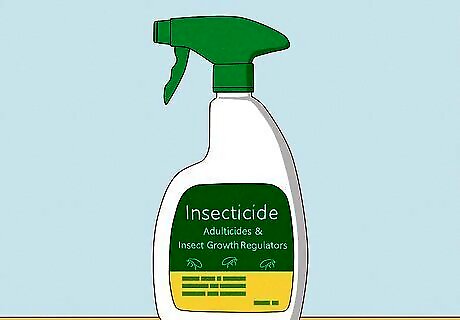
Buy insecticides with both adulticides and insect growth regulators. When you’re shopping around for an insecticide, look for ones that are labeled as both adulticides and growth regulators. These types of products will kill both adult fleas and any eggs or larvae. If you have pets, make sure that the product you choose is also non-toxic to animals.
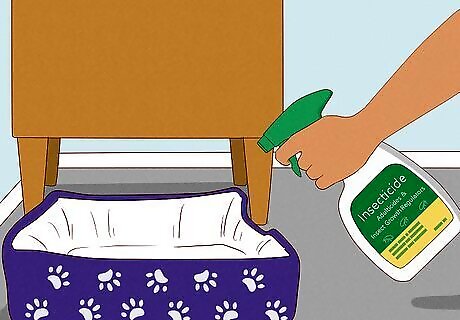
Apply the insecticide over the carpet. Be sure to also apply it underneath and on top of any furniture and on your pet’s bedding. Avoid spraying surfaces that you eat off of, like tables and countertops. Make sure everyone, pets included, is out of the house before you start spraying. Another option is to place flea foggers in each room of your house where the fleas are. Just make sure that all people and pets are out of the house before starting this type of treatment. Stay out of the house for 2 to 4 hours after using a fogger and also stay off of your carpet for 2 to 4 hours to allow insecticide sprays to dry completely. Make sure the room you’re treating is well-ventilated as you work. Open the windows or turn on a fan to get the air circulating.

Vacuum your carpet every day for about 2 weeks. It’s possible that the insecticide didn’t completely kill off all of the eggs, larvae, and adult fleas, so continue vacuuming the carpet thoroughly every day for about 2 weeks. If there are still fleas hanging around several weeks later, apply another treatment of insecticide.
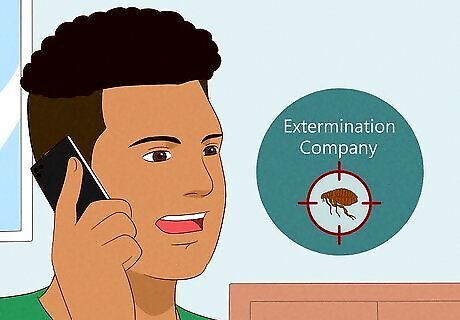
Call an extermination company for severe infestations. These companies will treat your house for fleas with professional-grade equipment and tackle any large infestations. Depending on the methods they use, you and anyone else in your house, including pets, may have to vacate the premises for a bit.
Preventing Infestations
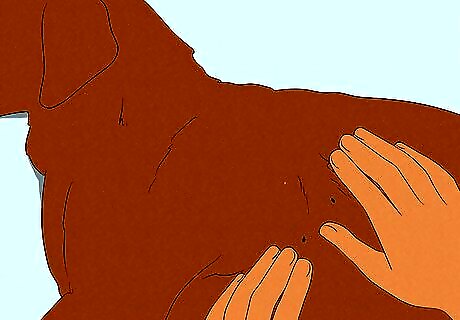
Check your pet’s fur for fleas. The fleas are most likely in your carpet because they came from your pet. In order to prevent the fleas from getting into your carpet, check your pet’s fur regularly for adult fleas. Also, keep a lookout for flea excrement (dark red specks) and eggs (white oval shapes the size of salt crystals) in your pet’s fur. If your pet is constantly scratching, this is another sign that it probably has fleas. Use a flea comb or brush to help remove fleas and their eggs from your pet’s fur. Dip the comb in soapy water to drown the fleas that you manage to pick out. Another way to kill fleas on your pet is to drown them by giving your pet a bath. There are even special flea shampoos for pets that will kill these pests. If your pet goes outside, consider getting a flea collar to help prevent them bringing fleas into the house.
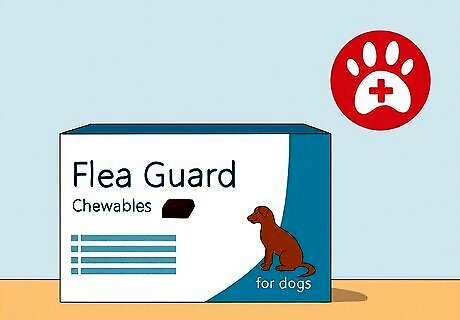
Treat pets with flea medication. Take your pet to a vet and ask what sort of flea medication would be the best for your pet. Your vet will then prescribe or recommend a medication type (cat or dog) and a dosage. If you’re choosing medication on your own, make sure that you read the label—it will tell you whether it’s for a cat or a dog, what age range it’s for, and what weight group it’s for. Flea medication can be oral or topical. If it’s topical, you’ll likely apply it to the base of your pet's neck right between their shoulder blades. Refer to the instructions on the label to find out how you should give the medication to your pet and how much you should be giving them. Watch your pet for any signs of discomfort or allergic reactions and take them to your vet immediately if you notice anything wrong. Never treat cats with dog flea medicine and vice versa, as medicines can be toxic if given to the wrong species.
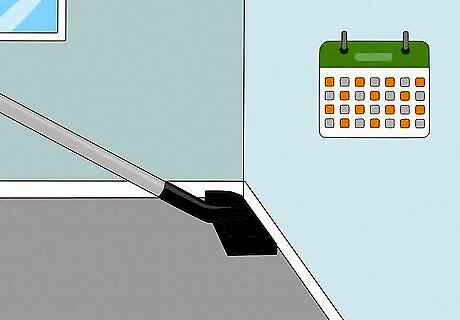
Vacuum your home regularly. Vacuuming every other day can help you get rid of adult fleas before they get a chance to lay their eggs. Be thorough each time and make sure to vacuum underneath all of your furniture, in small corners of each room, and near doors and windows where fleas can get in. And, of course, vacuum your carpet thoroughly and get near the baseboards.

















Comments
0 comment